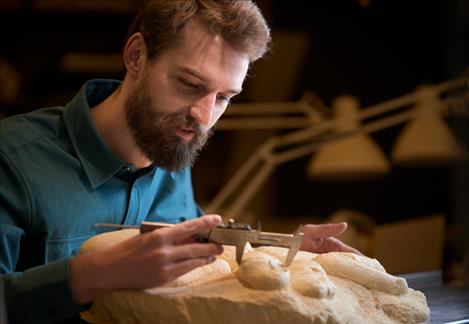Montana State student wins international prize for dinosaur nest research
Results of experimental study suggest possible bridge between crocodile and bird nesting habits
Hey savvy news reader! Thanks for choosing local.
You are now reading
1 of 3 free articles.
BOZEMAN — A Montana State University doctoral student has been awarded an international prize for his experimental study of dinosaur nesting strategies.
Jason Hogan, a student of paleontology in the Department of Earth Sciences in MSU’s College of Letters and Science, received the Alfred Sherwood Romer Prize from the Society of Vertebrate Paleontology after presenting his research at the society’s 2023 annual meeting. There, he described the experiment he devised to explore a possible evolutionary transition from the crocodile-like nesting habits of reptiles to those of modern birds.
Professor David Varricchio, head of MSU’s earth sciences department and Hogan’s faculty adviser, said it is only the second time an MSU student has won the Romer Prize, which is awarded annually in recognition of an outstanding contribution in vertebrate paleontology by a predoctoral student. The other was Greg Erickson, now a professor at Florida State University, who received the award in 1991.
Hogan’s award-winning experiment was inspired by about a half-dozen Chinese and Mongolian fossils of warm-blooded oviraptorosaurs sitting on nests of partially buried eggs. Those specimens – small, feathered dinosaurs from the Cretaceous period – were closely related to the lineage of modern birds.
Hogan said some researchers speculated that the adults guarded their egg clutches as modern crocodiles do; others believed they sat above the nests to keep eggs warm. Many scientists favored the first theory because they believed the ground would suck heat from the eggs, but Hogan wanted to see whether an adult situated above a nest could keep partially buried eggs above ambient temperature.
“Having a fossil of an adult sitting on a nest and knowing the adult was warm-blooded led us to a first experiment, which showed us it was not as inefficient as presumed,” Hogan said.
He also was intrigued by the oviraptorosaurs’ volcano-shaped nests, which contained rings of eggs placed at three levels. Such architecture and behavior are absent among species living today, but because the conical nests could accommodate more massive egg clutches over a smaller surface area than two-dimensional nests, Hogan speculated that may have allowed one adult to cover more eggs.
“It’s so odd that it has to be good at something,” Hogan said. “This behavior persisted through time, so they were clearly doing something well.”
To see if that something might include indirect contact incubation, Hogan built replicas of oviraptorosaur nests and stocked them with unviable emu eggs, which are similar to dinosaur eggs in mass, shell thickness and even their blue-green coloring. He placed thermometers into each egg, then set a surrogate parent dinosaur – essentially a 175-pound temperature-controlled hot water bottle – above the partially buried nests, then recorded temperatures of the eggs at pre-determined intervals. The results indicated that a warm-blooded adult sitting above a nest could transfer heat through the sediment into an egg clutch, suggesting a possible evolutionary link between buried crocodilian nests and the exposed bird nests seen in modern time periods.
Two papers describing Hogan’s work were published this year in the journals Paleobiology and Philosophical Transactions of the Royal Society.
Hogan, who holds a bachelor’s degree in earth and ocean science from Duke University and a master’s in science education from Harvard, has been at MSU for seven years. He decided to pursue a Ph.D. after teaching high school science for a few years because he was interested in teaching at the college level. He chose MSU for the opportunity to study with Varricchio and for the paleontology resources available at the Museum of the Rockies.
Varricchio said the Romer Prize recognized both the “very smart study” that Hogan conducted and his excellent presentation at the conference, which reflected his science education background and years as a science teacher.
“Winning the Romer is great for Jason, and also brings recognition to the paleontology work at Montana State,” Varricchio said. “I feel super fortunate to have Jason as part of our program.”
Hogan expects to finish his studies soon, then seek a teaching and research position at the university level. He said he is excited by advances in paleontology over the past 20 years, particularly the incorporation of more biology.
“There are lots of different ways to get into the field – you can dig in the dirt, be a biologist, study behavioral biology or be a statistician – it brings more life to the discipline,” he said. “It’s a lot of fun.”
















